- ▶
- Heaters/Source
- ▶
- Agilent Heaters and SensorsMass Spectrometry, Scientific Supplies & ManufacturingScientific Instrument Services 5973 Source Heater Tamper Resistant Allen Wrench 5973/5975 Quad Sensor 5985 Source Heater Assembly Agilent Interface Heater Assembly 5971 Interface Heater

- ▶
- Probes
- LiteratureApplication Notes Adsorbent Resins Guide Mass Spec Tips SDS Sheets FAQ MS Calibration Compound Spectra Manuals MS Links/Labs/ Organizations MS Online Tools Flyers on Products/Services Scientific Supplies Catalog About Us NextAdvance Bullet Blender® Homogenizer Protocols Micro-Mesh® Literature Instrumentation Literature Agilent GC/MS Literature SIS News / E-Mail Newsletter NIST MS Database - Update Notifications

- ▶
- Application NotesNote 103: EPA Method 325B, Novel Thermal Desorption Instrument Modification to Improve Sensitivity Note 102: Identification of Contaminants in Powdered Beverages by Direct Extraction Thermal Desorption GC/MS Note 101: Identification of Contaminants in Powdered Foods by Direct Extraction Thermal Desorption GC/MS Note 100: Volatile and Semi-Volatile Profile Comparison of Whole Versus Cracked Versus Dry Homogenized Barley Grains by Direct Thermal Extraction Note 99: Volatile and Semi-Volatile Profile Comparison of Whole vs. Dry Homogenized Wheat, Rye and Barley Grains by Direct Thermal Extraction GC/MS Note 98: Flavor and Aroma Profiles of Truffle Oils by Thermal Desorption GC/MS Note 97: Flavor Profiles of Imported and Domestic Beers by Purge & Trap Thermal Desorption GC/MS Note 96: Reducing Warping in Mass Spectrometer Filaments, with SISAlloy® Yttria/Rhenium Filaments Note 95: Detection of Explosives on Clothing Material by Direct and AirSampling Thermal Desorption GC/MS Note 94: Detection of Nepetalactone in the Nepeta Cataria Plant by Thermal Desorption GC/MS Note 93: Detection of Benzene in Carbonated Beverages with Purge & Trap Thermal Desorption GC/MS Note 92: Yttria Coated Mass Spectrometer Filaments Note 91: AutoProbe DEP Probe Tip Temperatures Note 90: An Automated MS Direct Probe for use in an Open Access Environment Note 89: Quantitation of Organics via a Mass Spectrometer Automated Direct Probe Note 88: Analysis of Silicone Contaminants on Electronic Components by Thermal Desorption GC-MS Note 87: Design and Development of an Automated Direct Probe for a Mass Spectrometer Note 86: Simulation of a Unique Cylindrical Quadrupole Mass Analyzer Using SIMION 7.0. Note 85: Replacing an Electron Multiplier in the Agilent (HP) 5973 MSD Note 84: Vacuum Pump Exhaust Filters - Charcoal Exhaust Traps Note 83: Vacuum Pump Exhaust Filters - Oil Mist Eliminators Note 82: Vacuum Pump Exhaust Filters Note 81: Rapid Bacterial Chemotaxonomy By DirectProbe/MSD Note 80: Design, Development and Testing of a Microprocessor ControlledAutomated Short Path Thermal Desorption Apparatus Note 79: Volatile Organic Compounds From Electron Beam Cured and Partially Electron Beam Cured Packaging Using Automated Short Path Thermal Desorption Note 78: A New Solution to Eliminate MS Down-Time With No-Tool-Changing of Analytical GC Columns Note 77: The Determination of Volatile Organic Compounds in VacuumSystem Components Note 76: Determination of the Sensitivity of a CRIMS System Note 75: An Apparatus for Sampling Volatile Organics From LivePlant Material Using Short Path Thermal Desorption Note 74: Examination of Source Design in Electrospray-TOF Using SIMION 3D Note 73: The Analysis of Perfumes and their Effect on Indoor Air Pollution Note 72: 1998 Version of the NIST/EPA/NIH Mass Spectral Library, NIST98 Note 71: Flavor Profile Determination of Rice Samples Using Shor tPath Thermal Desorption GC Methods Note 70: Application of SIMION 6.0 To a Study of the Finkelstein Ion Source: Part II Note 69: Application of SIMION 6.0 To a Study of the Finkelstein Ion Source: Part 1 Note 68: Use of a PC Plug-In UV-Vis Spectrometer To Monitor the Plasma Conditions In GC-CRIMS Note 67: Using Chemical Reaction Interface Mass Spectrometry (CRIMS) To Monitor Bacterial Transport In In Situ Bioremediation Note 66: Probe Tip Design For the Optimization of Direct Insertion Probe Performance Note 65: Determination of Ethylene by Adsorbent Trapping and Thermal Desorption - Gas Chromatography Note 64: Comparison of Various GC/MS Techniques For the Analysis of Black Pepper (Piper Nigrum) Note 63: Determination of Volatile and Semi-Volatile Organics in Printer Toners Using Thermal Desorption GC Techniques Note 62: Analysis of Polymer Samples Using a Direct Insertion Probe and EI Ionization Note 61: Analysis of Sugars Via a New DEP Probe Tip For Use With theDirect Probe On the HP5973 MSD Note 60: Programmable Temperature Ramping of Samples Analyzed ViaDirect Thermal Extraction GC/MS Note 59: Computer Modeling of a TOF Reflectron With Gridless Reflector Using SIMION 3D Note 58: Direct Probe Analysis and Identification of Multicomponent Pharmaceutical Samples via Electron Impact MS Note 57: Aroma Profiles of Lavandula species Note 56: Mass Spec Maintenance & Cleaning Utilizing Micro-Mesh® Abrasive Sheets Note 55: Seasonal Variation in Flower Volatiles Note 54: Identification of Volatile Organic Compounds in Office Products Note 53: SIMION 3D v6.0 Ion Optics Simulation Software Note 52: Computer Modeling of Ion Optics in Time-of-Flight mass Spectrometry Using SIMION 3D Note 51: Development and Characterization of a New Chemical Reaction Interface for the Detection of Nonradioisotopically Labeled Analytes Using Mass Spectrometry (CRIMS) Note 50: The Analysis of Multiple Component Drug Samples Using a Direct Probe Interfaced to the HP 5973 MSD Note 49: Analysis of Cocaine Utilizing a New Direct Insertion Probe on a Hewlett Packard 5973 MSD Note 48: Demonstration of Sensitivity Levels For the Detection of Caffeine Using a New Direct Probe and Inlet for the HP 5973 MSD Note 47: The Application Of SIMION 6.0 To Problems In Time-of-Flight Mass Spectrometry Note 46: Delayed Extraction and Laser Desorption: Time-lag Focusing and Beyond Note 45: Application of SIMION 6.0 to Filament Design for Mass Spectrometer Ionization Sources Note 44: The Design Of a New Direct Probe Inlet For a Mass Spectrometer Note 43: Volatile Organic Composition In Blueberries Note 42: The Influence of Pump Oil Purity on Roughing Pumps Note 41: Hydrocarbon Production in Pine by Direct Thermal Extraction Note 40: Comparison of Septa by Direct Thermal Extraction Note 39: Comparison of Sensitivity Of Headspace GC, Purge and Trap Thermal Desorption and Direct Thermal Extraction Techniques For Volatile Organics Note 38: A New Micro Cryo-Trap For Trapping Of Volatiles At the Front Of a GC Capillary Column Note 37: Volatile Organic Emissions from Automobile Tires Note 36: Identification Of Volatile Organic Compounds In a New Automobile Note 35: Volatile Organics Composition of Cranberries Note 34: Selection Of Thermal Desorption and Cryo-Trap Parameters In the Analysis Of Teas Note 33: Changes in Volatile Organic Composition in Milk Over Time Note 32: Selection and Use of Adsorbent Resins for Purge and Trap Thermal Desorption Applications Note 31: Volatile Organic Composition in Several Cultivars of Peaches Note 30: Comparison Of Cooking Oils By Direct Thermal Extraction and Purge and Trap GC/MS Note 29: Analysis Of Volatile Organics In Oil Base Paints By Automated Headspace Sampling and GC Cryo-Focusing Note 28: Analysis Of Volatile Organics In Latex Paints By Automated Headspace Sampling and GC Cryo-Focusing Note 27: Analysis of Volatile Organics In Soils By Automated Headspace GC Note 26: Volatile Organics Present in Recycled Air Aboard a Commercial Airliner Note 25: Flavor and Aroma in Natural Bee Honey Note 24: Selection of GC Guard Columns For Use With the GC Cryo-Trap Note 23: Frangrance Qualities in Colognes Note 22: Comparison Of Volatile Compounds In Latex Paints Note 21: Detection and Identification Of Volatile and Semi-Volatile Organics In Synthetic Polymers Used In Food and Pharmaceutical Packaging Note 20: Using Direct Thermal Desorption to Assess the Potential Pool of Styrene and 4-Phenylcyclohexene In Latex-Backed Carpets Note 19: A New Programmable Cryo-Cooling/Heating Trap for the Cryo-Focusing of Volatiles and Semi-Volatiles at the Head of GC Capillary Columns Note 18: Determination of Volatile Organic Compounds In Mushrooms Note 17: Identification of Volatile Organics in Wines Over Time Note 16: Analysis of Indoor Air and Sources of Indoor Air Contamination by Thermal Desorption Note 14: Identification of Volatiles and Semi-Volatiles In Carbonated Colas Note 13: Identification and Quantification of Semi-Volatiles In Soil Using Direct Thermal Desorption Note 12: Identification of the Volatile and Semi-Volatile Organics In Chewing Gums By Direct Thermal Desorption Note 11: Flavor/Fragrance Profiles of Instant and Ground Coffees By Short Path Thermal Desorption Note 10: Quantification of Naphthalene In a Contaminated Pharmaceutical Product By Short Path Thermal Desorption Note 9: Methodologies For the Quantification Of Purge and Trap Thermal Desorption and Direct Thermal Desorption Analyses Note 8: Detection of Volatile Organic Compounds In Liquids Utilizing the Short Path Thermal Desorption System Note 7: Chemical Residue Analysis of Pharmaceuticals Using The Short Path Thermal Desorption System Note 6: Direct Thermal Analysis of Plastic Food Wraps Using the Short Path Thermal Desorption System Note 5: Direct Thermal Analysis Using the Short Path Thermal Desorption System Note 4: Direct Analysis of Spices and Coffee Note 3: Indoor Air Pollution Note 2: Detection of Arson Accelerants Using Dynamic Headspace with Tenax® Cartridges Thermal Desorption and Cryofocusing Note 1: Determination of Off-Odors and Other Volatile Organics In Food Packaging Films By Direct Thermal Analysis-GC-MS Tech No. "A" Note 14: Elimination of "Memory" Peaks in Thermal Desorption Improving Sensitivity in the H.P. 5971 MSD and Other Mass Spectrometers - Part I of II Improving Sensitivity in the H.P. 5971 MSD and Other Mass Spectrometers- Part II of II Adsorbent Resins Guide Development and Field Tests of an Automated Pyrolysis Insert for Gas Chromatography. Hydrocarbon Production in Pine by Direct Thermal Extraction A New Micro Cryo-Trap for the Trapping of Volatiles at the Front of a GC Capillary (019P) - Comparison of Septa by Direct Thermal Extraction Volatile Organic Composition in Blueberry Identification of Volatile Organic Compounds in Office Products Detection and Indentification of Volatiles in Oil Base Paintsby Headspace GC with On Column Cryo-Trapping Evaluation of Septa Using a Direct Thermal Extraction Technique INFLUENCE OF STORAGE ON BLUEBERRY VOLATILES Selection of Thermal Desorption and Cryo-Trap Parameters in the Analysis of Teas Redesign and Performance of a Diffusion Based Solvent Removal Interface for LC/MS The Design of a New Direct Probe Inlet for a Mass Spectrometer Analytes Using Mass Spectrometry (CRIMS) Application of SIMION 6.0 to Filament Design for Mass Spectrometer Ionization Sources A Student Guide for SIMION Modeling Software Application of SIMION 6.0 to Problems in Time-of-flight Mass Spectrometry Comparison of Sensitivity of Headspace GC, Purge and TrapThermal Desorption and Direct Thermal Extraction Techniques forVolatile Organics The Influence of Pump Oil Purity on Roughing Pumps Analysis of Motor Oils Using Thermal Desorption-Gas Chromatography-Mass Spectrometry IDENTIFICATION OF VOLATILE ORGANIC COMPOUNDS IN PAPER PRODUCTS Computer Modeling of Ion Optics in Time-of-Flight mass Spectrometry using SIMION 3D Seasonal Variation in Flower Volatiles Development of and Automated Microprocessor Controlled Gas chromatograph Fraction Collector / Olfactometer Delayed Extraction and Laser Desorption: Time-lag Focusing and Beyond A New Micro Cryo-Trap for the Trapping of Volatiles at the Front of a GC Column Design of a Microprocessor Controlled Short Path Thermal Desorption Autosampler Computer Modeling of Ion Optics in Time-of-Flight Mass Spectrometry Using SIMION 3D Thermal Desorption Instrumentation for Characterization of Odors and Flavors

- ▶
- Note 69: Application of SIMION 6.0 To a Study of the Finkelstein Ion Source: Part 1 (This Page)
Presented at EAS, Summerset, NJ., November 1997
Part 1 | Part 2
INTRODUCTION
In 1940, A. Theodore Finkelstein described a unique ion source for the generation of intense ion beams [1]. This source was unique in that an ionizing beam of electrons was introduced co-linear to the final beam of ions. The co-propagation of charged particles was assisted by a magnetic field and dramatically increased the flux of ions from the source. We investigate the possibility of using the Finkelstein source for the introduction of ions into a mass spectrometer. Simulations are performed using the SIMION 3D software program. Both a generic conventional ion source and a Finkelstein source are modeled and comparisons are made of their efficiencies. In order for these results to be of general use, the simulation process is described in sufficient detail so that the reader can use these methods on more specific examples.
Software
The results reported in this poster were generated with the ion optics
program SIMION 3D v.6.0. This software was developed by David Dahl at the
Idaho National Engineering Laboratory [2]. The latest version allows for
greatly expanded simulation capabilities. These include larger array sizes
(10 million points) and three dimensional modeling. The new capabilities
of dynamic parameter variation, time varying potentials, and user programming
are also employed in the work below.
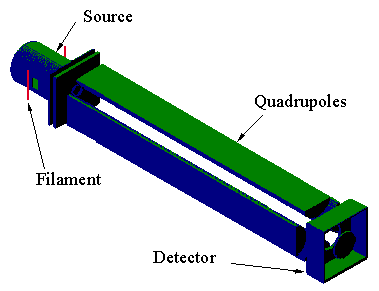
Figure 1A
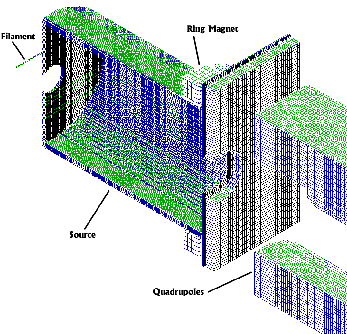
Figure 1B
Fig. 1 - Simulated quadrupole mass spectrometer: (A) Conventional generic source, mass filter, and detector. (B). Cutaway of Finkelstein source. (Not shown are a filament shield and second magnetic pole located behind the filament.)
Simulation
SIMION was used to model the quadrupole mass spectrometers shown in Figure 1. Details of the simulation of the conventional ion source have been reported previously [3]. The simulation was divided into five sections. Each of these was designed and "refined" individually. (Refining is SIMION's method of calculating the potentials on non-electrode points.) The sections are then placed on an Ion Optics Bench (IOB) in their proper positions. The IOB feature allows items to be reused in different simulations. For example, parts of the quadrupole mass filter in this work were taken from an example that is included with the software. The IOB also permits the use of pieces whose symmetries differ. It is often helpful to incorporate elements of symmetry in the simulation because they dramatically reduce the number of array points required. Likewise, sections of the simulation can have a different number of grid points per unit area. This allows for more accurate simulations where needed, such as around the filament, without requiring such high precision everywhere else in the instrument.
The five sections (or instances) used in our experiments were a magnet, the source, the region between the source and the start of the quadrupoles, the quadrupoles, and the volume including the end of the quadrupoles and detector. The source instance consisted of a cylindrical piece (1.5 cm long X 1.0 cm dia.) with a flat plate at one end. In the conventional source a "repeller" was positioned on the side facing away from the quadrupoles. The plate included a 2 mm aperture to pass ions into the mass analyzer. Two planes of symmetry along the main axis of the instrument were used to divide the number of points in the calculation by a factor of four. A 2 x 3 mm slit was placed in the source to allow electrons from the filament to enter. (Because of the symmetry used, our simulation included two identical filaments and slits.) A magnetic instance was placed over the source so that an appropriate magnetic field was generated. The instance between the source and the quadrupoles included an electrode with another 2 mm aperture. In many actual instruments, an einzel lens is placed in this area. The instance also incorporated a section of the quadrupoles in order to properly model the transition between these two regions of the instrument. The quadrupoles were modeled in two dimensions and then "extruded" along the axis of the instrument in the IOB. The final instance modeled the transition between the end of the quadrupoles and the detector.
In the Finkelstein source, the -70V filament was placed behind the source (See Fig. 1B). An electron entrance hole was placed at the bottom of the source volume. The entire source was held at ground with the exception of the place that included the ion exit aperture. This surface was held at a potential of -1V. A ring magnet was placed around the ion exit and an opposite pole (not shown) was placed beneath the filament. Also not shown in Fig. 1B is a shield, held at -70V, directly behind the filament. The magnetic field within the center of the ion source had a strength of approximately 350 Gauss.
Electrons and ions were simulated using SIMION's trajectory calculations.
The potentials of the quadrupoles were varied at a radio frequency of 1.1
MHz in order to pass ions of 100 m/z. Control of the time dependent potentials
was accomplished using SIMION's user programming interface. Each simulation
was performed using groups of ions. Within each group, electrons were assumed
to leave a filament at 10 different points covering a linear range of 2
mm. At each of these points, five electrons were generated with different
angular trajectories. All electrons were given 0.25 eV of kinetic energy.
Before the simulation of each group, a random number was generated for
use in determining where electrons should turn into positive ions of 100
m/z. This was intended to simulate the electron impact ionization of neutral
species. The simulation was repeated a large number of times in order to
model the random generation of ions in the region between the two filaments.
The complete source code for all user programs used in this simulation
are available on the Internet [4].
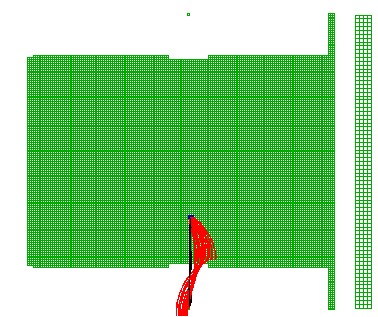 A
A
Figure 2A
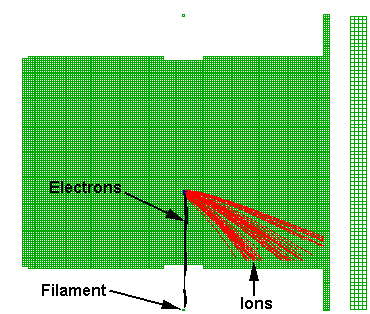 B
B
Figure 2B
 C
C
Figure 2C
Fig. 2 - Sample simulations in conventional source. (In A and B only the source region is shown. Views are along the y-axis).
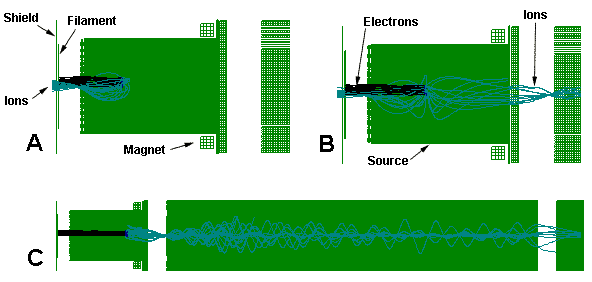
Fig. 3 - Sample Simulation In the Finkelstein Source
Results
Figures 2 and 3 show the simulation of three ion groups from each of the two ion sources. These are intended to show examples of the possible fates of the simulated ions. In the first case (A), ions are formed too close to the filament. They are therefore drawn back toward the filament. This was the most common path for ions to take in both sources. In the second case (B), ions are generated closer to the center of the source. In the conventional source these are eliminated by striking the front and side walls. In the final case (C), ions are shown passing into the mass filter. Some of these ions reach the detector. However, the random initial thermal kinetic energy of the ions is sufficient to prevent some of these from reaching the detector.
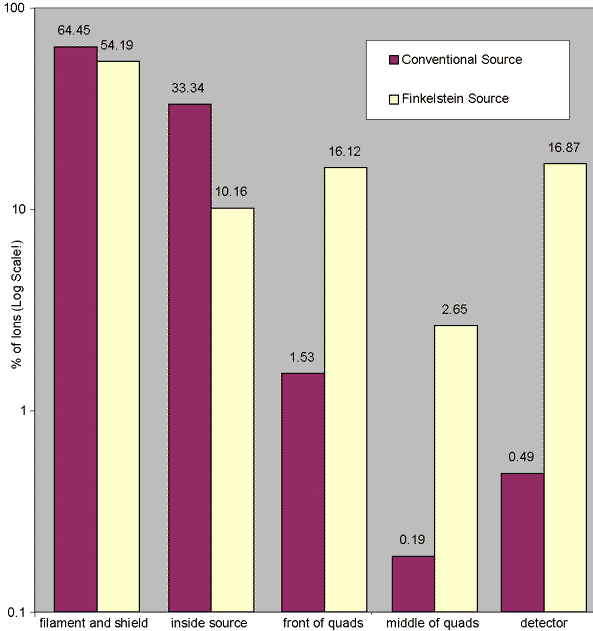
Fig. 4 - Location of Ion Impacts For the Two Sources
The probabilities of ion elimination occurring in each region of the instrument are compared in Figure 4. In the conventional source, over 64% of the ions are lost through the filament opening. This is due to both the magnetic and electric fields of the source. The fraction of ions lost through this route is a function of the size and depth of the rectangular opening used to admit electrons into the source. A plot of potential energy contours of the conventional source is shown in Figure 5A. Ions are accelerated in directions perpendicular to the red lines shown. It is clear that only in the center region are ions directed towards the exit aperture. Those ions that do move towards the exit are accelerated into the plane of Figure 5 (xz plane) by the magnetic field. As a result, the ions that strike the front plate of the source do so, on average, below the level of the principal instrument axis. As was shown in Figure 3, those ions that do not travel towards the filament still have only a small chance of reaching the detector. The Finkelstein source has an attractor in the source rather than a repeller. This generates the fields shown in Figure 5B and dramatically improves the acceleration of ions toward the ion exit.
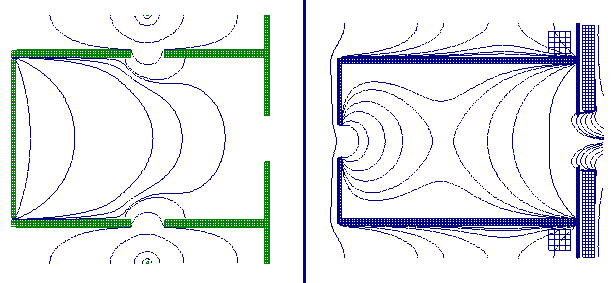
Fig. 5 - Potential Energy Contours of the Source Regions
Using SIMION's data recording menu, it is possible to determine the starting positions of the ions that reach the detector. This enables us to determine the zone in which detectable ions may be generated. The volumes found were approximately 0.15 x 1.7 x 1.4 mm for the conventional source and 10 x 0.8 x 2.8 mm for the Finkelstein source.
Limitations of the Simulation (Warnings!)
Our goal in this presentation has been to demonstrate methods for instrument analysis and design and examine a possible source design. We are not attempting to characterize a specific instrument. However, as with any computer modeling, there are limitations to these simulations that must be kept in mind when analyzing the results. For example, the user program allows electrons to generate ions before they reach a significant kinetic energy. The simulated system was not optimized so the potentials chosen are not likely to be the best for ion collection in this system. Likewise, the specific geometry used was not based on an actual instrument or an optimal design. We have also not included the einzel lenses found in many commercial instruments. This will certainly have a dramatic influence on the collection efficiency of ions.
There are also some clear disadvantages to the Finkelstein source. For example, photons from the filament are likely to generate significant noise at the detector. The ions produced in the Finkelstein source also have a kinetic energy distribution of 0.6 eV while those in the conventional source have a distribution of 0.02 eV. This is will have a significant effect on the performance of the mass filter.
Current Work
Our next project will be a further characterization of the Finkelstein source. This will include an examination of the effects of the initial ion kinetic energy on the instrument resolution and the possibility of using a magnetic bottle to contain the electrons.
Conclusions
We have demonstrated the use of SIMION 3D in modeling two ion source regions for a quadrupole mass spectrometer. The software is an excellent tool for the investigation of ion optics within the instrument. We believe that the work of David Dahl will contribute to a large variety of applications.
SIMION 7 and 8 users can download source files here: download simion-finksim.zip. (Note: these files are fairly old. They are based on the "quad" example in SIMION 6.0, which has since been updated in SIMION 8.0/8.1.
References
1. A. Theodore Finkelstein, Review of Scientific Instruments, v.11 (1940) p94.
2. David A. Dahl 43ed ASMS 1995, pg. 717.
3. S. M. Colby, C. W. Baker, and J. J. Manura 44th ASMS 1996 pgxx.
4. http://www.sisweb.com


